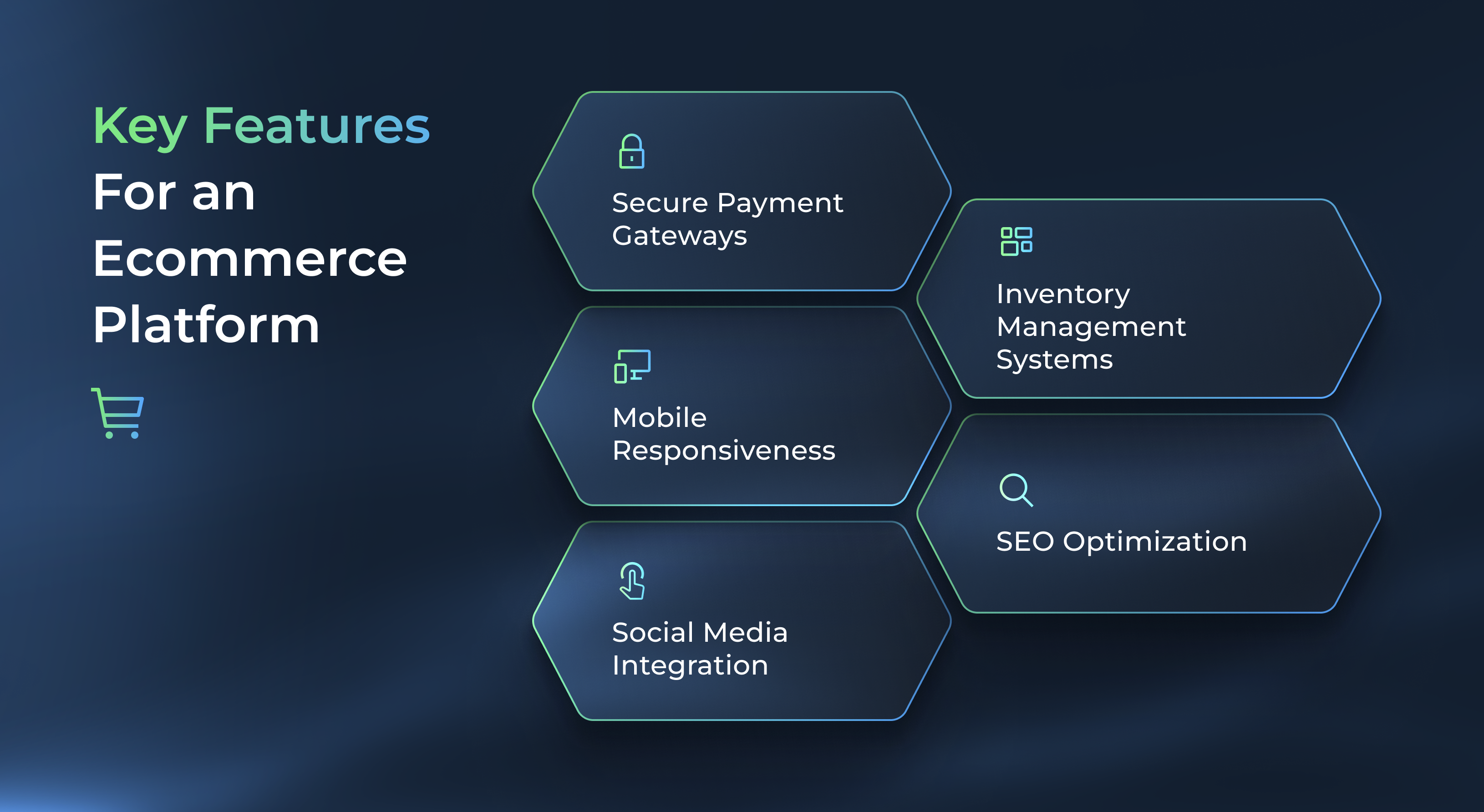In today’s digital age, having a strong online presence is crucial for retail businesses looking to thrive and succeed. Building a successful retail e-commerce platform is not only essential for reaching a wider audience, but also for staying competitive in a rapidly evolving market. At WeSoftYou, we understand the importance of a well-designed and efficient e-commerce platform. With our expertise in software development, we have helped countless businesses transform their retail operations into thriving online enterprises. In this article, we will guide you through the essential steps involved in building a successful retail e-commerce platform.
E-Commerce Platform Planning
Building a successful retail e-commerce platform begins with careful planning and strategizing. From identifying your target audience to setting clear business goals, the planning phase sets the foundation for your e-commerce venture.
- Identify Your Target Audience: Conduct thorough market research to understand the demographics, interests, and shopping habits of your potential customers. Tailor your platform to meet their needs for a seamless shopping experience.
- Set Clear Business Goals: Define the purpose of your e-commerce platform. Whether it’s increasing sales, expanding into new markets, or improving customer retention, having clear business goals guides your efforts and decision-making throughout the development process.
- Resource Allocation and Budgeting: Prioritize and allocate resources effectively based on your defined business goals. From marketing campaigns to website optimization, having a strategic vision enables wise budgeting for the success of your e-commerce platform.
- Analyze the Competitive Landscape: Conduct a comprehensive analysis of competitors to identify industry trends, customer expectations, and market gaps. Learn from competitors’ strengths and weaknesses to position your platform uniquely and offer exceptional value.
- Consider Scalability and Flexibility: Anticipate future growth by ensuring your e-commerce platform can handle increased traffic, sales volume, and product offerings. Planning for scalability avoids potential bottlenecks, ensuring a smooth user experience as your business expands.
In conclusion, meticulous planning is the cornerstone of a successful e-commerce platform. By understanding your audience, defining business goals, analyzing the competition, and considering scalability, you lay a robust foundation for development and future growth.
The Right E-Commerce Platform Choice
With a wide array of e-commerce platforms available, choosing the right one is crucial for the success of your retail venture. Different platforms offer different features and functionalities, so it’s important to compare your options and select the one that best suits your business needs.
When it comes to selecting an e-commerce platform, there are several factors to consider. One of the most important factors is ease of use. You want a platform that is intuitive and user-friendly, allowing you to easily manage your online store without any technical expertise. Platforms like Shopify, WooCommerce, and Magento are popular choices known for their user-friendly interfaces and robust features.
Customization options are another key consideration. You want a platform that allows you to customize the look and feel of your online store to match your brand identity. This includes the ability to choose from a variety of themes and templates, as well as the option to add custom code if needed. A highly customizable platform will give you the flexibility to create a unique and engaging shopping experience for your customers.
Scalability is also an important factor to consider. As your business grows, you want a platform that can grow with you. Look for a platform that offers scalability, allowing you to easily add new products, handle increased traffic, and expand your online store without any technical limitations.
Integration capabilities are another aspect to keep in mind. You want a platform that seamlessly integrates with other tools and services you may need, such as payment gateways, shipping providers, and marketing automation software. This will ensure that your online store operates smoothly and efficiently, without any disruptions or manual workarounds.
Comparing Different E-Commerce Platforms
When comparing e-commerce platforms, consider factors such as ease of use, customization options, scalability, and integration capabilities. Platforms like Shopify, WooCommerce, and Magento are popular choices known for their user-friendly interfaces and robust features. We at WeSoftYou have experience working with a variety of platforms, and can help you make an informed decision based on your unique requirements.
Shopify is a leading e-commerce platform that offers a wide range of features and benefits. It provides an easy-to-use interface, making it ideal for beginners or those with limited technical knowledge. Shopify also offers a variety of themes and templates, allowing you to create a visually appealing online store. Additionally, it has a strong support system, with 24/7 customer support available to assist you with any issues or questions you may have.
WooCommerce, on the other hand, is a popular choice for businesses that already have an existing WordPress website. It seamlessly integrates with WordPress, allowing you to add e-commerce functionality to your existing site. WooCommerce offers a high level of customization, with a wide range of plugins and extensions available to enhance the functionality of your online store. It also provides a strong community of developers and users, offering support and resources to help you get the most out of the platform.
Magento is a powerful and scalable e-commerce platform that is suitable for larger businesses with complex requirements. It offers advanced customization options, allowing you to create a highly tailored online store. Magento also provides robust features for inventory management, order processing, and customer segmentation. However, it does require more technical expertise to set up and maintain compared to other platforms.
Key Features For a Platform

When evaluating e-commerce platforms, keep an eye out for essential features such as secure payment gateways, inventory management systems, mobile responsiveness, SEO optimization, and social media integration. These features will ensure that your e-commerce platform is fully equipped to meet the needs of your customers and drive conversions.
- Secure Payment Gateways: Ensure the platform offers secure payment options, instilling customer trust with robust security measures against fraud and data breaches.
- Inventory Management Systems: Opt for platforms with advanced inventory features, including real-time tracking, low stock alerts, and support for managing multiple warehouses or fulfillment centers.
- Mobile Responsiveness: Prioritize platforms with responsive design to guarantee seamless functionality and an appealing look across various devices, acknowledging the prevalent use of mobile devices for online shopping.
- SEO Optimization: Look for platforms with built-in SEO features like customizable meta tags, URL structures, and XML sitemaps to enhance your store’s visibility in search engine results and attract organic traffic.
- Social Media Integration: Choose platforms that seamlessly integrate with popular social media platforms, facilitating effective product promotion and audience engagement on social media channels.
In conclusion, choosing the right e-commerce platform is a critical decision that can greatly impact the success of your online retail venture. By considering factors such as ease of use, customization options, scalability, and integration capabilities, as well as key features like secure payment gateways, inventory management systems, mobile responsiveness, SEO optimization, and social media integration, you can make an informed decision that aligns with your business needs and goals.
E-Commerce Website Design
Having a visually appealing and user-friendly website is key to attracting and retaining customers. Your e-commerce website should not only showcase your products effectively, but also provide an intuitive and seamless browsing experience.
When it comes to designing your e-commerce website, there are several factors to consider. One of the most important aspects is the user-friendly design. A user-friendly design is paramount when it comes to e-commerce platforms. Visitors should be able to navigate your website easily, find the products they are looking for, and complete their purchases without any hassle.
Streamlining the purchasing process is crucial. Minimizing the number of clicks required to complete a purchase can greatly enhance the user experience. By optimizing your website for fast loading times, you can further improve the browsing experience and reduce the chances of visitors leaving your site due to slow loading pages.
Importance of User-Friendly Design
A user-friendly design is not only important for the convenience of your customers, but it also has a direct impact on your conversion rates. Studies have shown that websites with a user-friendly design tend to have higher conversion rates compared to those with a complicated and confusing layout.
By creating a website that is easy to navigate, you can help your customers find what they are looking for quickly and efficiently. This can lead to higher customer satisfaction and increased sales. Additionally, a user-friendly design can also help build trust and credibility with your customers, as it shows that you value their time and strive to provide them with a positive experience.
Optimizing Your Site for Mobile
In today’s digital age, the use of mobile devices for online shopping has become increasingly popular. Therefore, it is crucial to optimize your e-commerce website for mobile. Responsive design ensures that your website adapts to different screen sizes, providing a seamless experience across all devices.
By optimizing your site for mobile, you can capture the growing mobile user base and drive more conversions. Mobile optimization not only improves the user experience but also helps with search engine optimization (SEO). Search engines like Google prioritize mobile-friendly websites in their search results, making it easier for potential customers to find your site.
When optimizing your site for mobile, it’s important to consider factors such as page load speed, touch-friendly buttons, and simplified navigation. These elements can greatly enhance the mobile browsing experience and encourage users to stay on your site longer, increasing the chances of them making a purchase.
In conclusion, designing a visually appealing and user-friendly e-commerce website is crucial for the success of your online business. By focusing on user-friendly design and optimizing your site for mobile, you can create a seamless browsing experience that attracts and retains customers, ultimately driving more conversions and increasing your sales.
Secure Transactions
Ensuring the security of your customers’ personal and payment information is of utmost importance in building trust and credibility. Implementing the necessary security measures will protect your customers’ data and give them peace of mind when making transactions on your e-commerce platform.
Importance of SSL Certificates
An SSL (Secure Sockets Layer) certificate is an essential security feature that encrypts the data transferred between your customers’ browsers and your website. This prevents hackers from intercepting sensitive information such as credit card details. Displaying the SSL certificate prominently on your website will instill trust in your customers and help increase conversions.
Choosing a Reliable Payment Gateway
A payment gateway is the software that securely authorizes and processes online payments. It’s crucial to choose a reliable payment gateway that supports multiple payment options and ensures seamless transactions. Research different payment gateway providers and select the one that meets your specific requirements for security, fees, and integration capabilities.
Inventory and Shipping
Efficiently managing your inventory and shipping processes is vital for providing a smooth shopping experience to your customers. Streamlining these operations will help you avoid stockouts, fulfill orders promptly, and keep your customers satisfied.
Selecting an Inventory Management System
An inventory management system allows you to track and organize your products, monitor stock levels, and automate order fulfillment. Invest in an inventory management system that integrates seamlessly with your e-commerce platform and provides real-time updates to avoid overselling or understocking.
Understanding Shipping Options and Costs
Understanding different shipping options and their associated costs is crucial for effectively managing your e-commerce platform. Research various shipping carriers and compare their rates, delivery times, and reliability. Offering multiple shipping options to your customers, including expedited shipping, will enhance their shopping experience and increase customer satisfaction.
Success Measurement and Scaling Of Business
No e-commerce platform is complete without measuring key performance indicators (KPIs) and implementing strategies for business growth and expansion. By regularly analyzing data and adapting your strategies, you can continuously improve your platform and scale your business to new heights.
Key Performance Indicators for E-Commerce
Track important metrics such as conversion rate, average order value, customer acquisition cost, and customer lifetime value to gauge the success of your e-commerce platform. Analyze this data to identify areas of improvement and implement strategies to optimize your e-commerce operations.
Strategies for Business Growth and Expansion
From launching targeted marketing campaigns to expanding your product offerings, there are several strategies you can implement to grow and expand your retail e-commerce platform. Continuously monitor market trends, stay updated with customer preferences, and tailor your strategies to meet the evolving needs of your target audience.
Building a successful retail e-commerce platform requires careful planning, strategic decision-making, and a deep understanding of your target audience. With the expertise of WeSoftYou, you can confidently embark on your e-commerce journey, knowing that you have a trusted partner by your side. Contact us today for a free consultation or project estimation and let us help you transform your retail business into a thriving online enterprise.
Conclusion
In today’s digital landscape, a robust online presence is not just advantageous; it’s a necessity for retail success. WeSoftYou, with its expertise in software development, has empowered numerous businesses to transition seamlessly into thriving online enterprises. This guide outlines key steps for crafting a successful retail e-commerce platform.
E-commerce, revolutionizing retail, offers diverse models like B2C and B2B, enabling businesses to adapt to changing consumer preferences. Beyond boosting sales, e-commerce reduces costs linked to physical storefronts and provides valuable insights for data-driven decision-making. The journey to a successful retail e-commerce platform starts with meticulous planning, from identifying the target audience to setting clear business goals. Selecting the right e-commerce platform, considering key features, and designing an intuitive interface are vital for attracting and retaining customers.
Contact us for a free consultation or project estimation and let us assist you in developing a successful e-commerce platform.





















